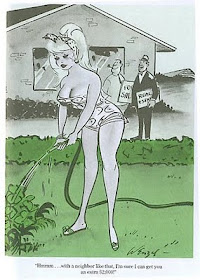Kathryn Schulz:
"...the lazy man’s “Every unhappy family is unhappy in its own way” is “Fuck this shit.”...In The Mother Tongue, Bill Bryson argues that okay is “the quintessential Americanism” and “the most grammatically versatile of words.” Okay. But surely it has a rival—or a compatriot—in fuck. Wherever it originated (the jury is out), the F-word has flourished in our adolescent American soil. And pace Bryson, its grammatical versatility cannot be topped: You can use it as noun, verb, adverb, adjective, or interjection, not to mention in any mood whatsoever, from exultation to rage..."
('Ode to a Four-Letter Word/ And I don’t mean "okay."')
Jason Flores-Williams:
“Hipster culture today is harmless culture. And that’s an epic tragedy because being hip used to mean that you were heroic and dangerous. That you waged war on soullessness and greed through art and resistance. Being hip meant that you wanted upheaval in society. Being hip meant you were intense lower class, not detached upper class. Being hip meant being revolutionary.”
दुर्गा भागवत: "'लेखकराव' म्हणून इतरांना नावं ठेवणारे स्वतःच लेखकराव होवून बसले"
[Durga Bhagwat: Those who teased others as "establishment-writers" themselves became establishment-writers (insiders)]
The one guy who never became one- Bhau Padhye.
(Contrast this with, from another field, some one like Mr. Sunil Gavaskar, once an enfant terrible of Indian cricket, is now the establishment.)
The title of this post contains a Marathi word मवाली ('Mavali'). Mavali translates as rogue/ hooligan/ hoodlum/ ruffian. One meaning of 'rogue' is 'something or someone different from what is normal or expected'. Indeed, if anyone, Bhau was different.
Recently I came across following.
Economic and Political Weekly dated July 31 2011 has an essay by Juned Shaikh: "Translating Marx: Mavali, Dalit and the Making of Mumbai’s Working Class, 1928-1935"
'The Communist Manifesto' was translated into Marathi as 'Kamyunista Jahirnama' (कम्युनिस्ट जाहीरनामा) in Meerut jail in 1930-31 by Gangadhar Adhikari (गंगाधर अधिकारी) a scientist who had completed his PhD in chemistry from Berlin University in 1926.
The Jahirnama’s classified people in the city of Mumbai into the categories of such as kamgaar, Mavali and dalit.
"Adhikari used the term “mavali” to signify the lumpenproletariat. Mavali, a moniker for people from the hilly regions of western Maharashtra in the Bombay Presidency, signified categories of people prone to create law and order problems for the colonial police. In his explication of key words to the Marathi edition of the Manifesto that was published along with the Jahirnama, Adhikari characterised the Mavali as a class below the working class, who were “paupers” and lived in the city’s slums...Destitute and unemployed workers, paupers, and the lumpenproletariat are a step below the kamgaar varga on the social ladder...
He translated a passage from Das Capital to explain this point further:
"उद्योगधंद्यातून काढून टाकलेले लोक मोठ्यावस्तीच्या शहरातून गर्दी करुन राहतात; व गुंड, दादालोक, मवाली म्ह्णून प्रसिद्धीस येतात. उत्पादन क्रियेची व यांची कायमची फारकत झाली असते; असे लोक अर्थातच पैशा करीता वाटेल त्या प्रतिगामी पक्षाला स्वताला विकण्यास मागे पुढे पहात नाहीत. (The paupers who have been fired from work live in crowded slums in cities and become famous as criminals- (mavali). They have been permanently separated from the means of production and therefore these people do not think twice before selling themselves to counter-revolutionary forces for money).
Mavali indeed is a very complex term.
My affection for Bhau Padhye has been expressed a few times on this blog. One such instance is here.
Recently I read Mr. Narayan Bandekar's (नारायण बांदेकर) interview of Mr. Padhye here.
Agreeing with his high-profile and vocal critic Acharya Atre (आचार्य अत्रे), Bhau admits he is a rogue (मवाली).
"'वासूनाक्या'वरील आचार्य अत्र्यांच्या लेखात मला 'मवाली' म्हटलं व भटकळांनी बदनामीचा खटला करण्यास मला मदत करण्याचं आश्वासन दिलं. पण मला वाटलं, आचार्य अत्र्यांनी मला ही बेस्ट पदवी दिली. माझी वास्तव जीवनातील प्रतिमा का आली कुणास ठाऊक- मी घर उघड्यावर टाकलं नाही एवढ्यावरून-? बाकी सगळं केलं, (म्हणजे बाई, बाटली वगैरे!) मला वाटतं- माझा चष्मा, शोशन्नाचं सामाजिक कार्य आणि समाजवादी बॅकग्राउंड यामुळं ही गफलत झाली असावी. तुम्ही विश्वास ठेवा किंवा ठेवू नका, पण कॉलेज जीवनात काही मुलींनी मला खरोखरच 'मवाली' ठरवलं होतं!"
(Acharya Atre called me a rogue in his article on 'Vasunaka' and Bhatkal promised help to file a lawsuit for libel. But I thought, Acharya Atre has really given me a very good title. I don't know why my image in real life was formed- just because I never abandoned the house- did everything else, (means alcohol, women etc!) I think - my glasses, Shoshanna's social work and socialist background- they created mixup. You believe it or not, but in college life some girls indeed concluded that I was a rogue!")
Now this 'rogue' quality of Bhau is captured so beautifully in following 'cool' picture- spiky hair- more like Havells : Shock Laga ad- on head, wrinkles on forehead, beedi dangling from mouth, glasses, his horizontal stripe little short shirt exposing his crotch, hands in pockets, slightly bent right knee, a bunch of chest hair, and don't-give-a-damn attitude...
(Bhau would have surely liked my reference to Havells ad! For him life was sum total of all that happened around him. There was nothing higher or lower.)
 Artist: Vasant Sarwate (वसंत सरवटे) from 'Nivadak Thanthanpal' (निवडक ठणठणपाळ ),1969
Artist: Vasant Sarwate (वसंत सरवटे) from 'Nivadak Thanthanpal' (निवडक ठणठणपाळ ),1969ERIN MCKEAN has said: "We like to think that human languages should be more like computer-programming languages: logical, orderly, efficient and goal-oriented. But they are more like our own DNA: complicated and full of junk information but at the same time gloriously mutable, able (for good or ill) to give rise to new living forms." (WSJ, August 10 2011)
Bhau played his part in the process of Marathi's mutation and while doing it, I think, he never sold himself to counter-revolutionary forces for money. He always remained orthogonal. And many Marathi lovers are luckier for it.














